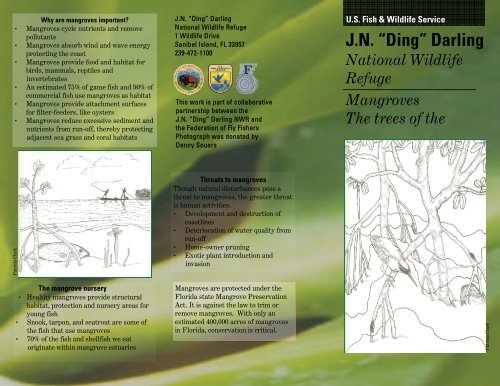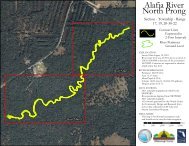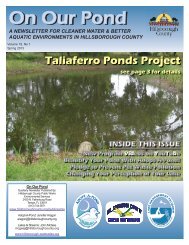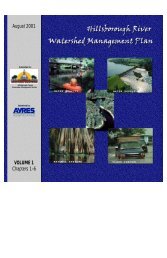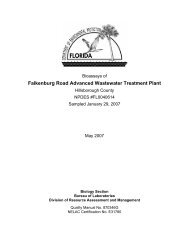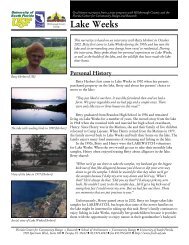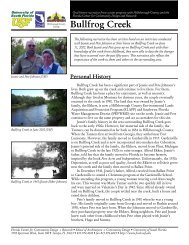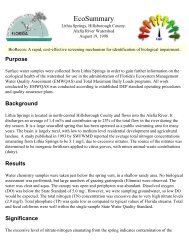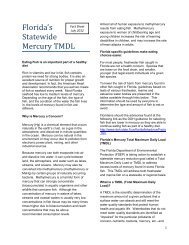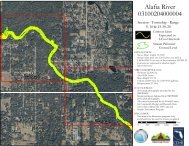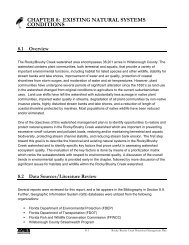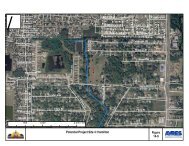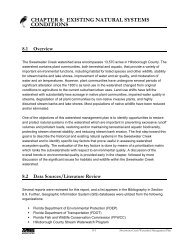You also want an ePaper? Increase the reach of your titles
YUMPU automatically turns print PDFs into web optimized ePapers that Google loves.
Why are mangroves important?<br />
• <strong>Mangrove</strong>s cycle nutrients and remove<br />
pollutants<br />
• <strong>Mangrove</strong>s absorb wind and wave energy<br />
protecting the coast<br />
• <strong>Mangrove</strong>s provide food and habitat for<br />
birds, mammals, reptiles and<br />
invertebrates<br />
• An estimated 75% of game fish and 90% of<br />
commercial fish use mangroves as habitat<br />
• <strong>Mangrove</strong>s provide attachment surfaces<br />
for filter-feeders, like oysters<br />
• <strong>Mangrove</strong>s reduce excessive sediment and<br />
nutrients from run-off, thereby protecting<br />
adjacent sea grass and coral habitats<br />
J.N. “Ding” Darling<br />
National Wildlife Refuge<br />
1 Wildlife Drive<br />
Sanibel Island, FL 33957<br />
239-472-1100<br />
This work is part of collaborative<br />
partnership between the<br />
J.N. “Ding” Darling NWR and<br />
the Federation of Fly Fishers<br />
Photograph was donated by<br />
Denny Souers<br />
U.S. Fish & Wildlife Service<br />
J.N. “Ding” Darling<br />
National Wildlife<br />
Refuge<br />
<strong>Mangrove</strong>s<br />
The trees of the<br />
Patricia Clark<br />
The mangrove nursery<br />
• Healthy mangroves provide structural<br />
habitat, protection and nursery areas for<br />
young fish<br />
• Snook, tarpon, and seatrout are some of<br />
the fish that use mangroves<br />
• 70% of the fish and shellfish we eat<br />
originate within mangrove estuaries<br />
Threats to mangroves<br />
Though natural disturbances pose a<br />
threat to mangroves, the greater threat<br />
is human activities.<br />
• Development and destruction of<br />
coastlines<br />
• Deterioration of water quality from<br />
run-off<br />
• Home-owner pruning<br />
• Exotic plant introduction and<br />
invasion<br />
<strong>Mangrove</strong>s are protected under the<br />
Florida state <strong>Mangrove</strong> Preservation<br />
Act. It is against the law to trim or<br />
remove mangroves. With only an<br />
estimated 400,000 acres of mangroves<br />
in Florida, conservation is critical.<br />
Patricia Clark
MANGROVE SPECIES OF FLORIDA<br />
What are mangroves?<br />
<strong>Mangrove</strong>s are tropical trees that grow in the<br />
intertidal environment. They are adapted to<br />
survive water-saturated soils, high salt<br />
concentrations and periodic tidal submergence.<br />
<strong>Mangrove</strong>s disperse their propagules by water.<br />
<strong>Mangrove</strong> communities are an integral part of<br />
Florida’s natural heritage.<br />
Red <strong>Mangrove</strong><br />
(Rhizophora mangle)<br />
• Grow 5 to 20 meters tall<br />
• Thick glossy leaves are opposite and<br />
elliptical with a dull underside<br />
• Arching stilt roots called “prop roots” and<br />
“drop roots”<br />
• Pencil-shaped propagule (seedling)<br />
• Filtration at the roots reduces salt intake<br />
bark<br />
Patricia Clark<br />
Red <strong>Mangrove</strong> Black mangrove White mangrove<br />
Black <strong>Mangrove</strong><br />
(Avicennia germinans)<br />
• Grow 15 to 20 meters tall<br />
• Shiny leaves are opposite with silver<br />
underside<br />
• Horizontal roots and upward projections at<br />
the base of the tree called pneumatophores<br />
• Lima bean-shaped propagule (seedling)<br />
• Excrete excess salt visible on leaf surface<br />
pneumatophores<br />
<strong>Mangrove</strong>s are<br />
adapted to live<br />
with different<br />
exposure to salt<br />
water. Red<br />
mangroves are<br />
found closest to<br />
the water’s edge.<br />
Black mangroves<br />
are found further<br />
inland, and white<br />
mangroves are<br />
found in the<br />
interior mangrove<br />
forest.<br />
White <strong>Mangrove</strong><br />
(Laguncularia racemosa)<br />
• Grow 15 meters tall<br />
• Leaves are opposite and succulent with<br />
notched tip<br />
• Nodules at the base of leaf<br />
• Tear drop-shaped propagule (seedling)<br />
• Excrete excess salt from leaf surface<br />
flower<br />
bark<br />
leaves and<br />
propagule<br />
Patricia Clark<br />
leaves<br />
propagule<br />
Patricia Clark<br />
leaves<br />
propagule<br />
Patricia Clark


